Project Management Methodologies Comparison Report - University Name
VerifiedAdded on 2021/04/17
|9
|1421
|122
Report
AI Summary
This report offers a detailed comparison of project management methodologies, specifically focusing on PRINCE2 and PMBOK. The report begins by defining project management methodologies from five different sources, highlighting their roles in project management. It then provides a comparative analysis of PRINCE2 and PMBOK, outlining their respective pros and cons. The core of the report relates the PRINCE2 methodology to the project life cycle, detailing its seven processes: project startup, project initiation, project direction, stage control, product delivery management, stage boundary management, and project closing. The report includes references to support the analysis and provides a comprehensive overview of the methodologies, their strengths, and their application within the project lifecycle. The report aims to provide a clear understanding of these methodologies for effective project management.
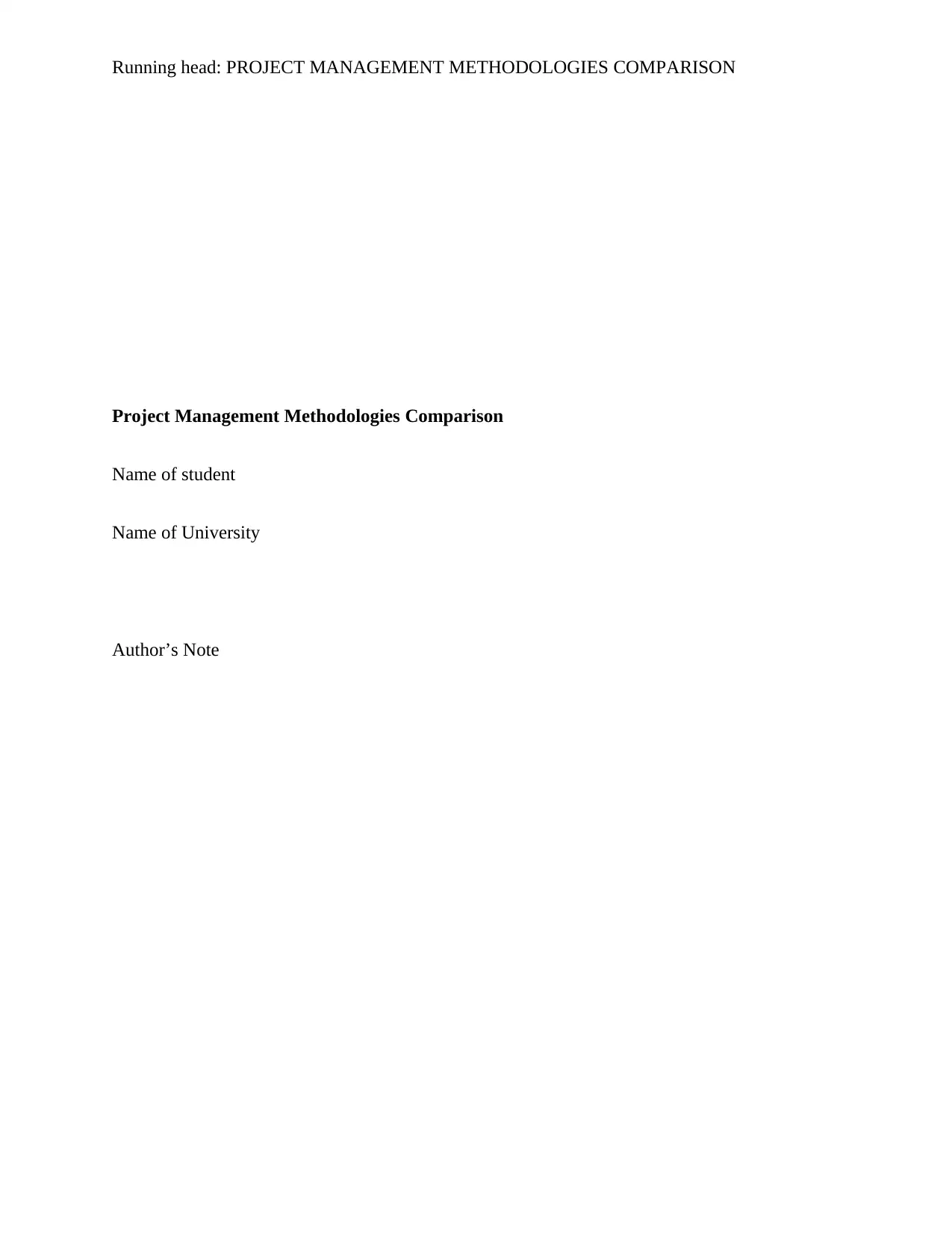
Running head: PROJECT MANAGEMENT METHODOLOGIES COMPARISON
Project Management Methodologies Comparison
Name of student
Name of University
Author’s Note
Project Management Methodologies Comparison
Name of student
Name of University
Author’s Note
Paraphrase This Document
Need a fresh take? Get an instant paraphrase of this document with our AI Paraphraser
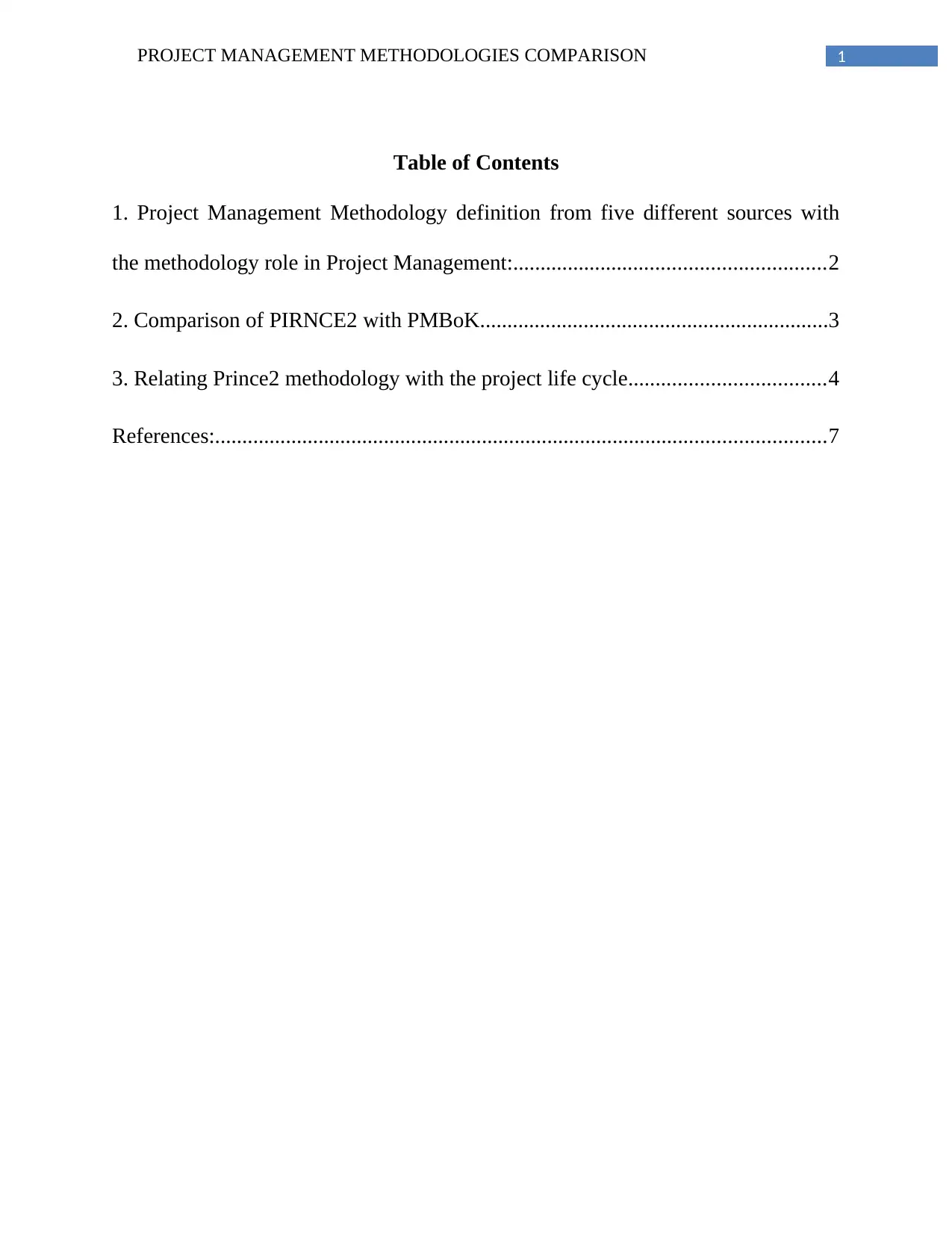
1PROJECT MANAGEMENT METHODOLOGIES COMPARISON
Table of Contents
1. Project Management Methodology definition from five different sources with
the methodology role in Project Management:.........................................................2
2. Comparison of PIRNCE2 with PMBoK................................................................3
3. Relating Prince2 methodology with the project life cycle....................................4
References:................................................................................................................7
Table of Contents
1. Project Management Methodology definition from five different sources with
the methodology role in Project Management:.........................................................2
2. Comparison of PIRNCE2 with PMBoK................................................................3
3. Relating Prince2 methodology with the project life cycle....................................4
References:................................................................................................................7
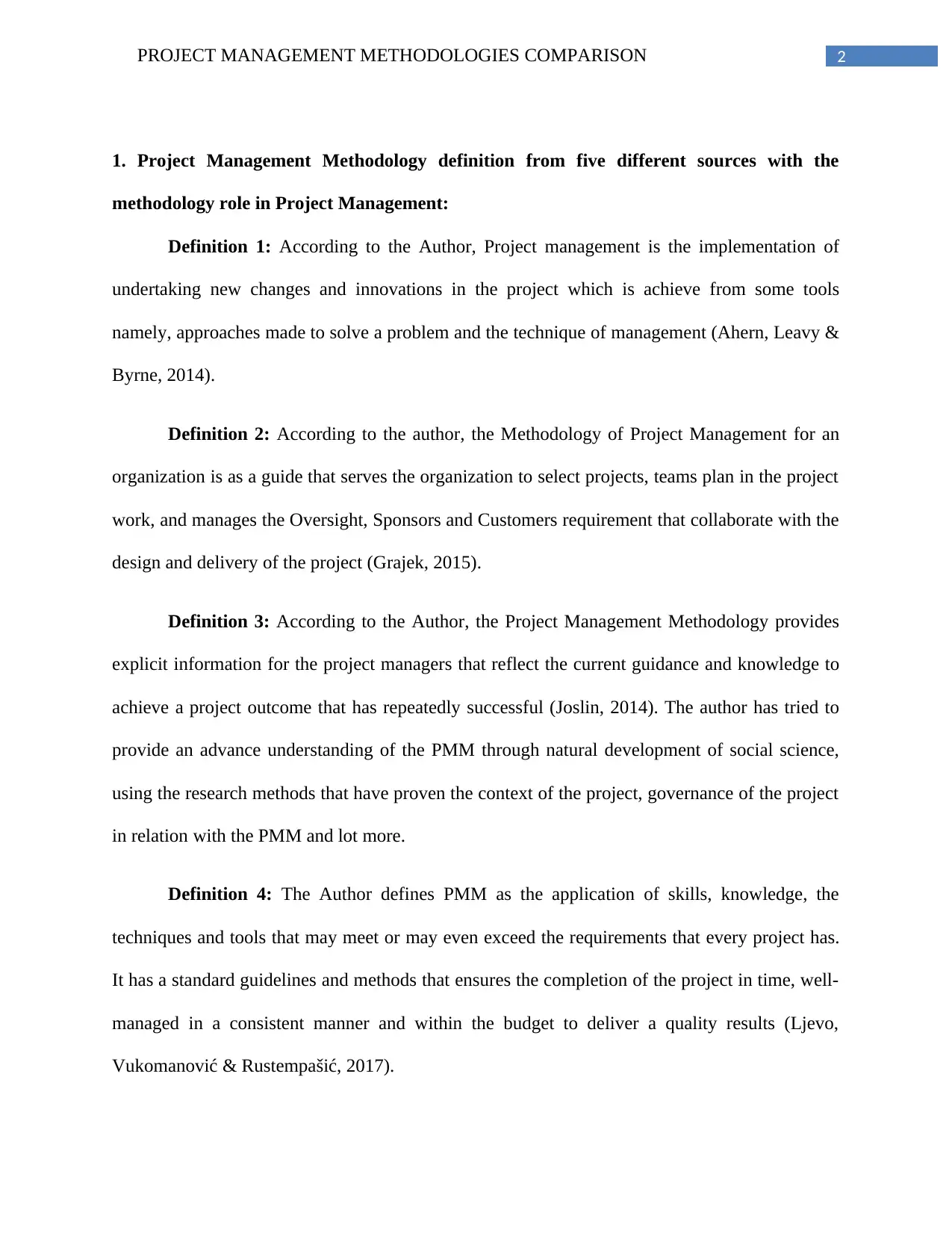
2PROJECT MANAGEMENT METHODOLOGIES COMPARISON
1. Project Management Methodology definition from five different sources with the
methodology role in Project Management:
Definition 1: According to the Author, Project management is the implementation of
undertaking new changes and innovations in the project which is achieve from some tools
namely, approaches made to solve a problem and the technique of management (Ahern, Leavy &
Byrne, 2014).
Definition 2: According to the author, the Methodology of Project Management for an
organization is as a guide that serves the organization to select projects, teams plan in the project
work, and manages the Oversight, Sponsors and Customers requirement that collaborate with the
design and delivery of the project (Grajek, 2015).
Definition 3: According to the Author, the Project Management Methodology provides
explicit information for the project managers that reflect the current guidance and knowledge to
achieve a project outcome that has repeatedly successful (Joslin, 2014). The author has tried to
provide an advance understanding of the PMM through natural development of social science,
using the research methods that have proven the context of the project, governance of the project
in relation with the PMM and lot more.
Definition 4: The Author defines PMM as the application of skills, knowledge, the
techniques and tools that may meet or may even exceed the requirements that every project has.
It has a standard guidelines and methods that ensures the completion of the project in time, well-
managed in a consistent manner and within the budget to deliver a quality results (Ljevo,
Vukomanović & Rustempašić, 2017).
1. Project Management Methodology definition from five different sources with the
methodology role in Project Management:
Definition 1: According to the Author, Project management is the implementation of
undertaking new changes and innovations in the project which is achieve from some tools
namely, approaches made to solve a problem and the technique of management (Ahern, Leavy &
Byrne, 2014).
Definition 2: According to the author, the Methodology of Project Management for an
organization is as a guide that serves the organization to select projects, teams plan in the project
work, and manages the Oversight, Sponsors and Customers requirement that collaborate with the
design and delivery of the project (Grajek, 2015).
Definition 3: According to the Author, the Project Management Methodology provides
explicit information for the project managers that reflect the current guidance and knowledge to
achieve a project outcome that has repeatedly successful (Joslin, 2014). The author has tried to
provide an advance understanding of the PMM through natural development of social science,
using the research methods that have proven the context of the project, governance of the project
in relation with the PMM and lot more.
Definition 4: The Author defines PMM as the application of skills, knowledge, the
techniques and tools that may meet or may even exceed the requirements that every project has.
It has a standard guidelines and methods that ensures the completion of the project in time, well-
managed in a consistent manner and within the budget to deliver a quality results (Ljevo,
Vukomanović & Rustempašić, 2017).
⊘ This is a preview!⊘
Do you want full access?
Subscribe today to unlock all pages.

Trusted by 1+ million students worldwide
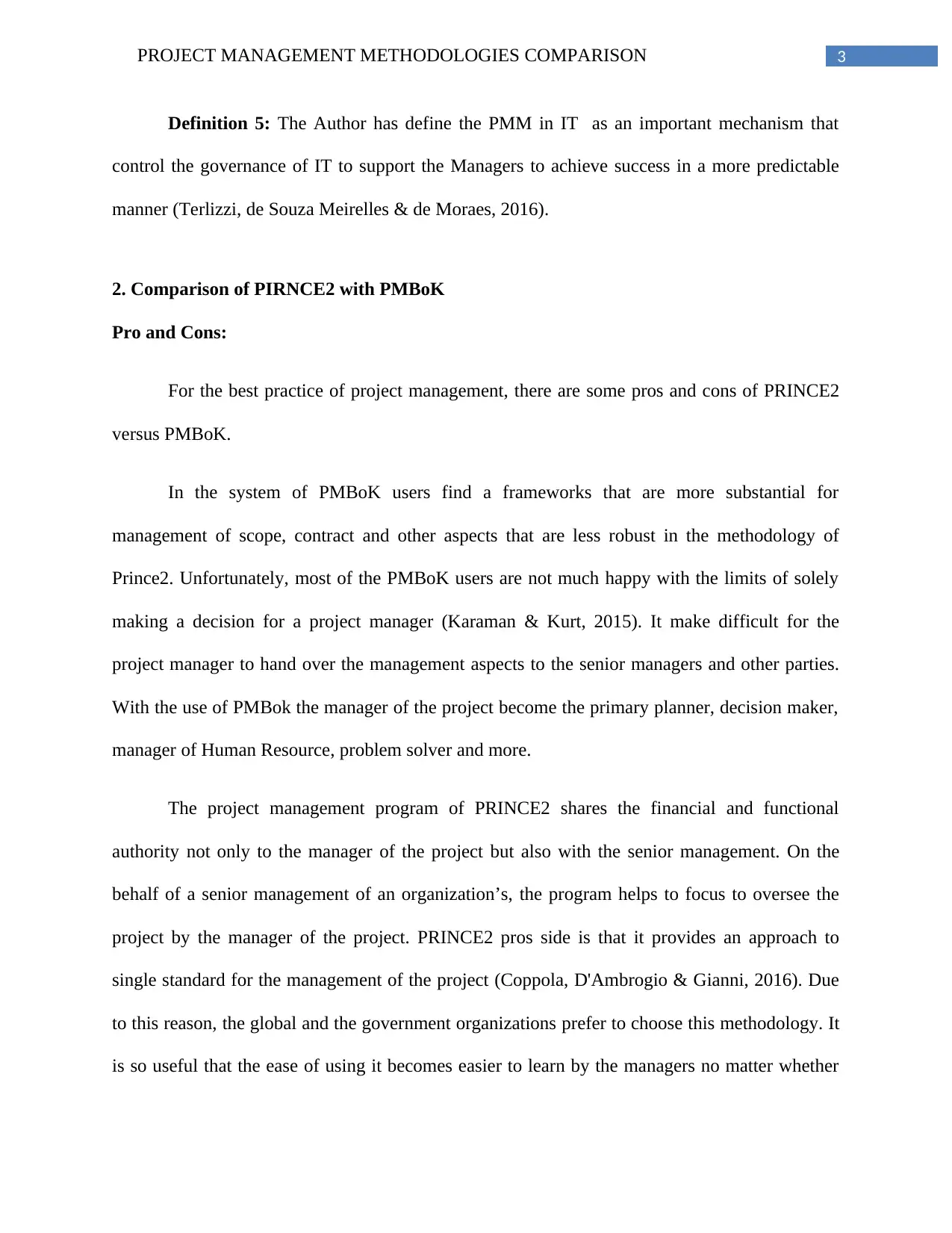
3PROJECT MANAGEMENT METHODOLOGIES COMPARISON
Definition 5: The Author has define the PMM in IT as an important mechanism that
control the governance of IT to support the Managers to achieve success in a more predictable
manner (Terlizzi, de Souza Meirelles & de Moraes, 2016).
2. Comparison of PIRNCE2 with PMBoK
Pro and Cons:
For the best practice of project management, there are some pros and cons of PRINCE2
versus PMBoK.
In the system of PMBoK users find a frameworks that are more substantial for
management of scope, contract and other aspects that are less robust in the methodology of
Prince2. Unfortunately, most of the PMBoK users are not much happy with the limits of solely
making a decision for a project manager (Karaman & Kurt, 2015). It make difficult for the
project manager to hand over the management aspects to the senior managers and other parties.
With the use of PMBok the manager of the project become the primary planner, decision maker,
manager of Human Resource, problem solver and more.
The project management program of PRINCE2 shares the financial and functional
authority not only to the manager of the project but also with the senior management. On the
behalf of a senior management of an organization’s, the program helps to focus to oversee the
project by the manager of the project. PRINCE2 pros side is that it provides an approach to
single standard for the management of the project (Coppola, D'Ambrogio & Gianni, 2016). Due
to this reason, the global and the government organizations prefer to choose this methodology. It
is so useful that the ease of using it becomes easier to learn by the managers no matter whether
Definition 5: The Author has define the PMM in IT as an important mechanism that
control the governance of IT to support the Managers to achieve success in a more predictable
manner (Terlizzi, de Souza Meirelles & de Moraes, 2016).
2. Comparison of PIRNCE2 with PMBoK
Pro and Cons:
For the best practice of project management, there are some pros and cons of PRINCE2
versus PMBoK.
In the system of PMBoK users find a frameworks that are more substantial for
management of scope, contract and other aspects that are less robust in the methodology of
Prince2. Unfortunately, most of the PMBoK users are not much happy with the limits of solely
making a decision for a project manager (Karaman & Kurt, 2015). It make difficult for the
project manager to hand over the management aspects to the senior managers and other parties.
With the use of PMBok the manager of the project become the primary planner, decision maker,
manager of Human Resource, problem solver and more.
The project management program of PRINCE2 shares the financial and functional
authority not only to the manager of the project but also with the senior management. On the
behalf of a senior management of an organization’s, the program helps to focus to oversee the
project by the manager of the project. PRINCE2 pros side is that it provides an approach to
single standard for the management of the project (Coppola, D'Ambrogio & Gianni, 2016). Due
to this reason, the global and the government organizations prefer to choose this methodology. It
is so useful that the ease of using it becomes easier to learn by the managers no matter whether
Paraphrase This Document
Need a fresh take? Get an instant paraphrase of this document with our AI Paraphraser
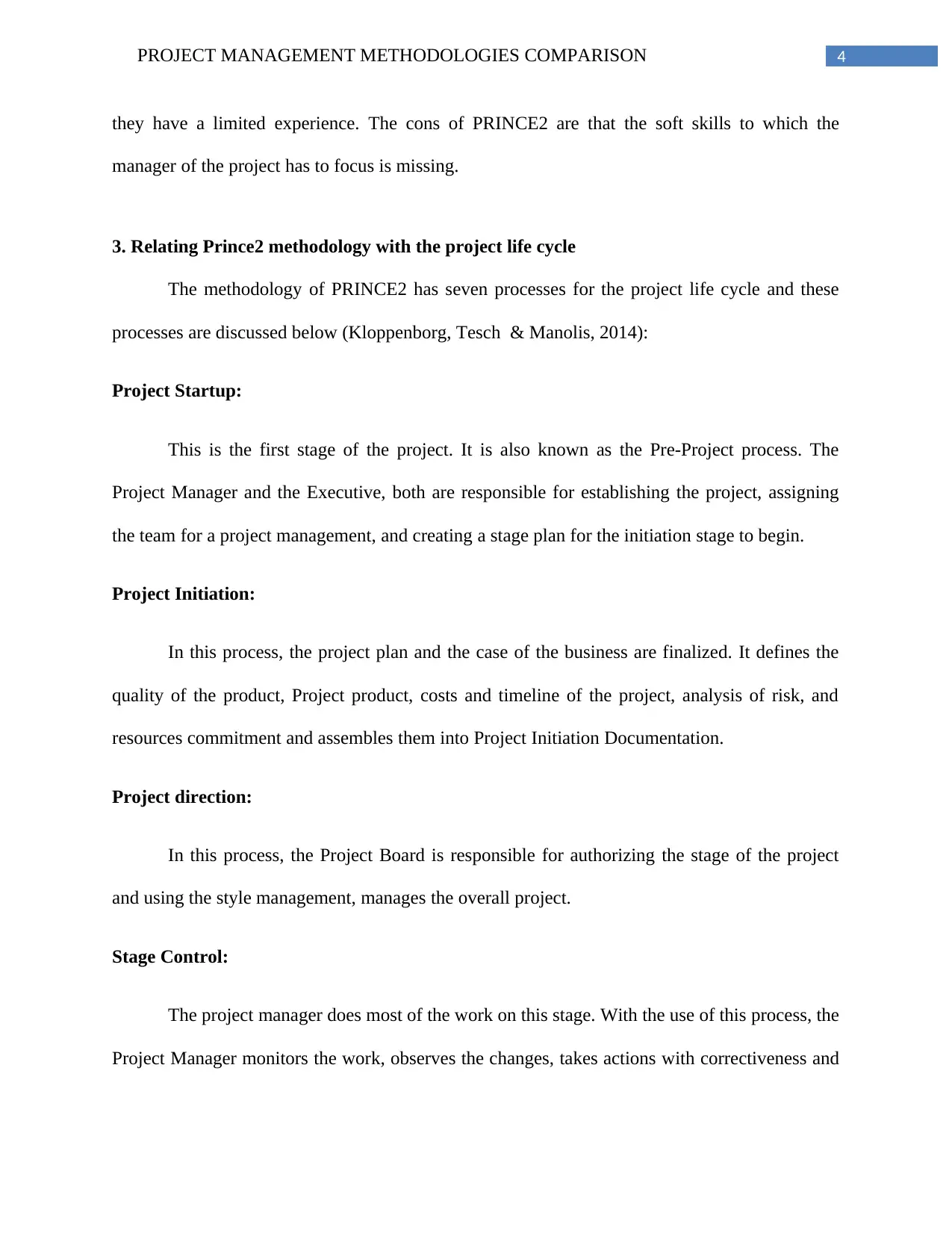
4PROJECT MANAGEMENT METHODOLOGIES COMPARISON
they have a limited experience. The cons of PRINCE2 are that the soft skills to which the
manager of the project has to focus is missing.
3. Relating Prince2 methodology with the project life cycle
The methodology of PRINCE2 has seven processes for the project life cycle and these
processes are discussed below (Kloppenborg, Tesch & Manolis, 2014):
Project Startup:
This is the first stage of the project. It is also known as the Pre-Project process. The
Project Manager and the Executive, both are responsible for establishing the project, assigning
the team for a project management, and creating a stage plan for the initiation stage to begin.
Project Initiation:
In this process, the project plan and the case of the business are finalized. It defines the
quality of the product, Project product, costs and timeline of the project, analysis of risk, and
resources commitment and assembles them into Project Initiation Documentation.
Project direction:
In this process, the Project Board is responsible for authorizing the stage of the project
and using the style management, manages the overall project.
Stage Control:
The project manager does most of the work on this stage. With the use of this process, the
Project Manager monitors the work, observes the changes, takes actions with correctiveness and
they have a limited experience. The cons of PRINCE2 are that the soft skills to which the
manager of the project has to focus is missing.
3. Relating Prince2 methodology with the project life cycle
The methodology of PRINCE2 has seven processes for the project life cycle and these
processes are discussed below (Kloppenborg, Tesch & Manolis, 2014):
Project Startup:
This is the first stage of the project. It is also known as the Pre-Project process. The
Project Manager and the Executive, both are responsible for establishing the project, assigning
the team for a project management, and creating a stage plan for the initiation stage to begin.
Project Initiation:
In this process, the project plan and the case of the business are finalized. It defines the
quality of the product, Project product, costs and timeline of the project, analysis of risk, and
resources commitment and assembles them into Project Initiation Documentation.
Project direction:
In this process, the Project Board is responsible for authorizing the stage of the project
and using the style management, manages the overall project.
Stage Control:
The project manager does most of the work on this stage. With the use of this process, the
Project Manager monitors the work, observes the changes, takes actions with correctiveness and
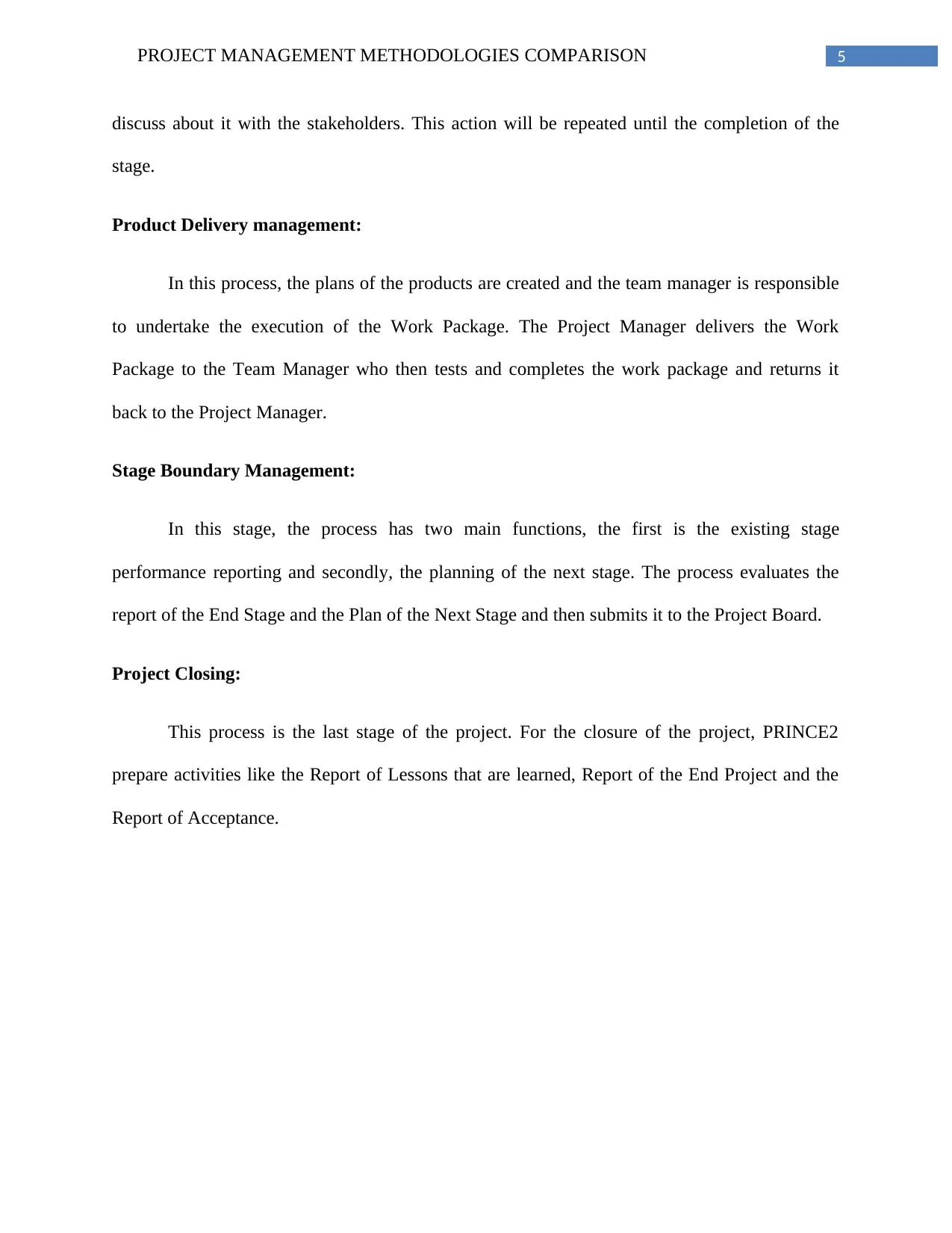
5PROJECT MANAGEMENT METHODOLOGIES COMPARISON
discuss about it with the stakeholders. This action will be repeated until the completion of the
stage.
Product Delivery management:
In this process, the plans of the products are created and the team manager is responsible
to undertake the execution of the Work Package. The Project Manager delivers the Work
Package to the Team Manager who then tests and completes the work package and returns it
back to the Project Manager.
Stage Boundary Management:
In this stage, the process has two main functions, the first is the existing stage
performance reporting and secondly, the planning of the next stage. The process evaluates the
report of the End Stage and the Plan of the Next Stage and then submits it to the Project Board.
Project Closing:
This process is the last stage of the project. For the closure of the project, PRINCE2
prepare activities like the Report of Lessons that are learned, Report of the End Project and the
Report of Acceptance.
discuss about it with the stakeholders. This action will be repeated until the completion of the
stage.
Product Delivery management:
In this process, the plans of the products are created and the team manager is responsible
to undertake the execution of the Work Package. The Project Manager delivers the Work
Package to the Team Manager who then tests and completes the work package and returns it
back to the Project Manager.
Stage Boundary Management:
In this stage, the process has two main functions, the first is the existing stage
performance reporting and secondly, the planning of the next stage. The process evaluates the
report of the End Stage and the Plan of the Next Stage and then submits it to the Project Board.
Project Closing:
This process is the last stage of the project. For the closure of the project, PRINCE2
prepare activities like the Report of Lessons that are learned, Report of the End Project and the
Report of Acceptance.
⊘ This is a preview!⊘
Do you want full access?
Subscribe today to unlock all pages.

Trusted by 1+ million students worldwide
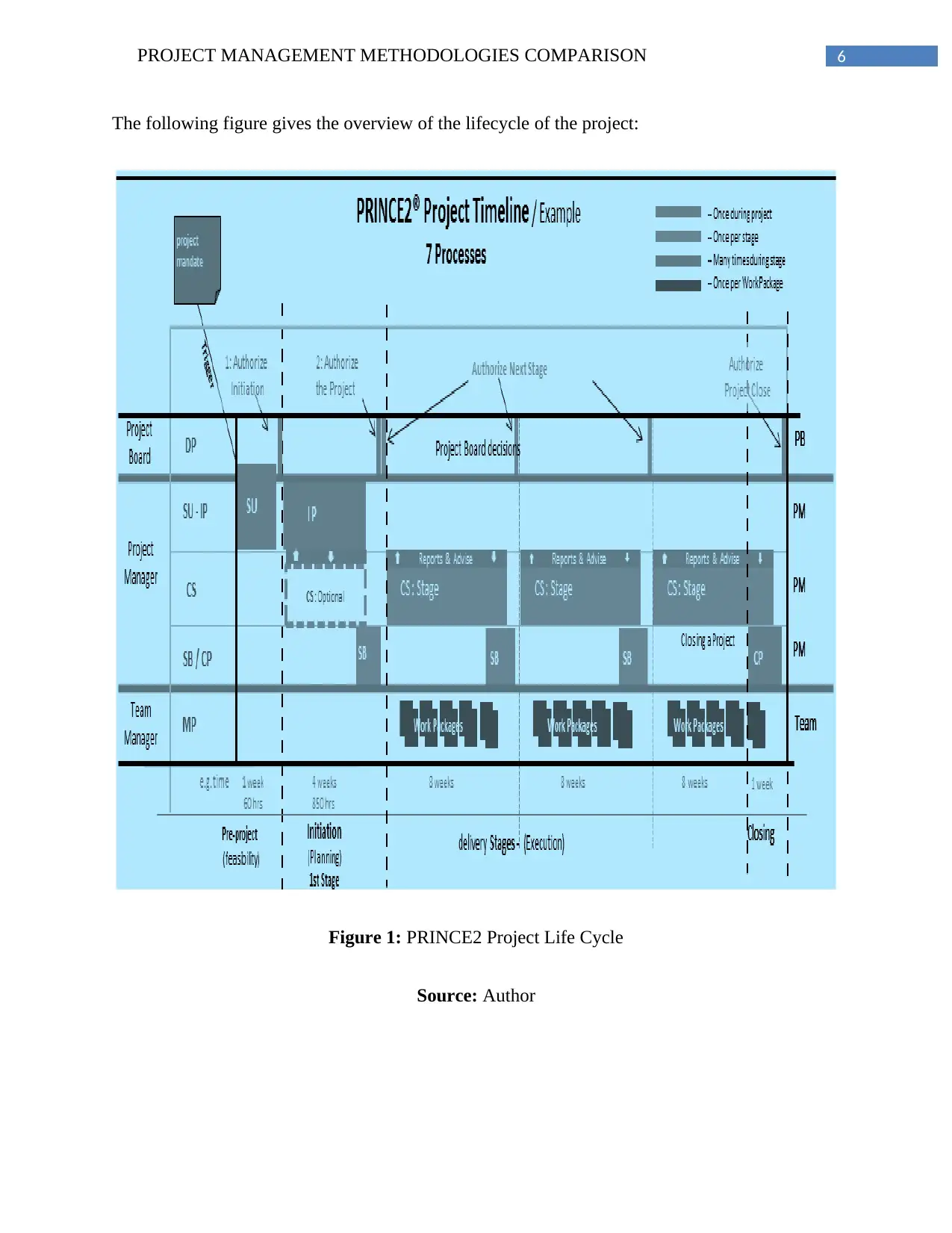
6PROJECT MANAGEMENT METHODOLOGIES COMPARISON
The following figure gives the overview of the lifecycle of the project:
Figure 1: PRINCE2 Project Life Cycle
Source: Author
The following figure gives the overview of the lifecycle of the project:
Figure 1: PRINCE2 Project Life Cycle
Source: Author
Paraphrase This Document
Need a fresh take? Get an instant paraphrase of this document with our AI Paraphraser
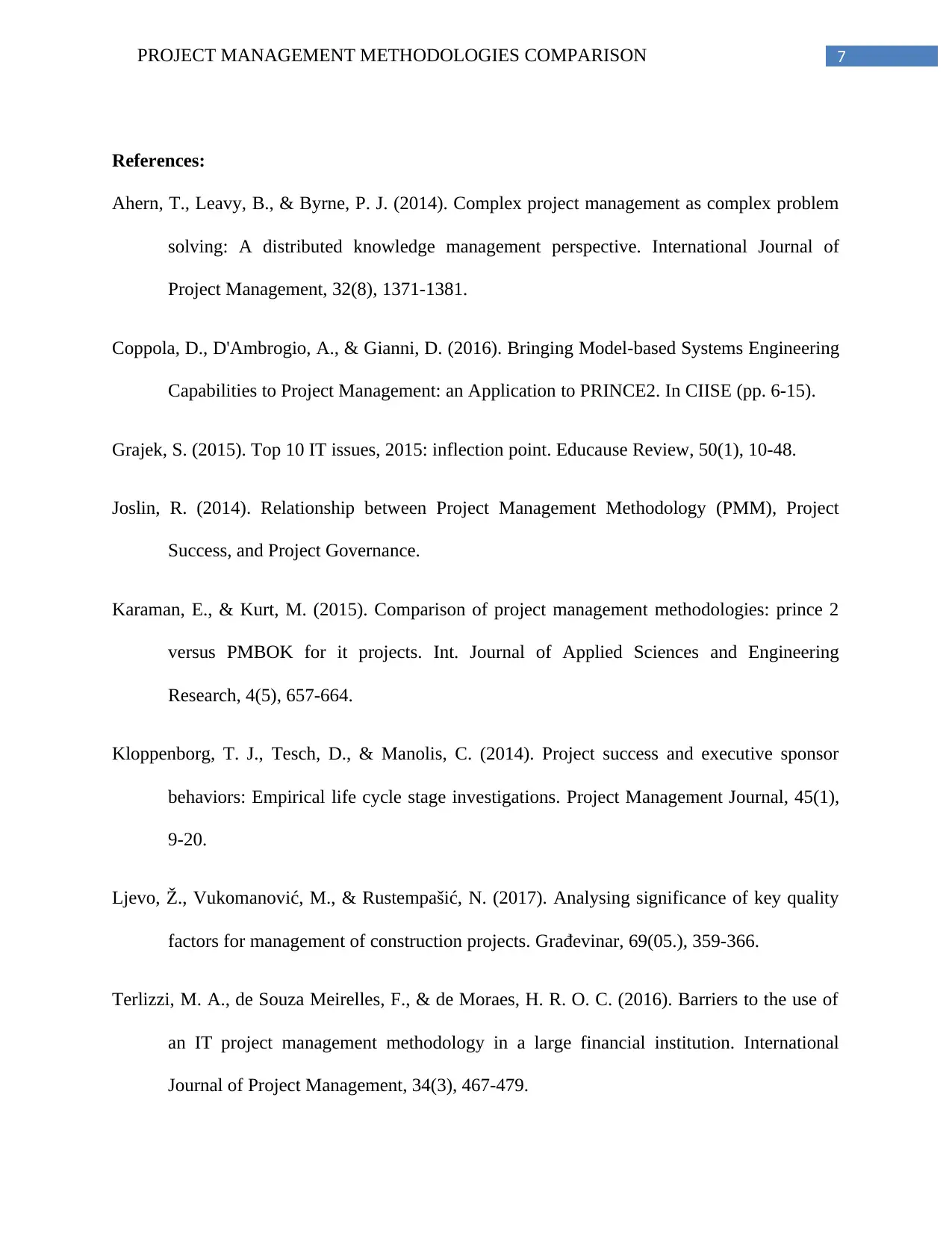
7PROJECT MANAGEMENT METHODOLOGIES COMPARISON
References:
Ahern, T., Leavy, B., & Byrne, P. J. (2014). Complex project management as complex problem
solving: A distributed knowledge management perspective. International Journal of
Project Management, 32(8), 1371-1381.
Coppola, D., D'Ambrogio, A., & Gianni, D. (2016). Bringing Model-based Systems Engineering
Capabilities to Project Management: an Application to PRINCE2. In CIISE (pp. 6-15).
Grajek, S. (2015). Top 10 IT issues, 2015: inflection point. Educause Review, 50(1), 10-48.
Joslin, R. (2014). Relationship between Project Management Methodology (PMM), Project
Success, and Project Governance.
Karaman, E., & Kurt, M. (2015). Comparison of project management methodologies: prince 2
versus PMBOK for it projects. Int. Journal of Applied Sciences and Engineering
Research, 4(5), 657-664.
Kloppenborg, T. J., Tesch, D., & Manolis, C. (2014). Project success and executive sponsor
behaviors: Empirical life cycle stage investigations. Project Management Journal, 45(1),
9-20.
Ljevo, Ž., Vukomanović, M., & Rustempašić, N. (2017). Analysing significance of key quality
factors for management of construction projects. Građevinar, 69(05.), 359-366.
Terlizzi, M. A., de Souza Meirelles, F., & de Moraes, H. R. O. C. (2016). Barriers to the use of
an IT project management methodology in a large financial institution. International
Journal of Project Management, 34(3), 467-479.
References:
Ahern, T., Leavy, B., & Byrne, P. J. (2014). Complex project management as complex problem
solving: A distributed knowledge management perspective. International Journal of
Project Management, 32(8), 1371-1381.
Coppola, D., D'Ambrogio, A., & Gianni, D. (2016). Bringing Model-based Systems Engineering
Capabilities to Project Management: an Application to PRINCE2. In CIISE (pp. 6-15).
Grajek, S. (2015). Top 10 IT issues, 2015: inflection point. Educause Review, 50(1), 10-48.
Joslin, R. (2014). Relationship between Project Management Methodology (PMM), Project
Success, and Project Governance.
Karaman, E., & Kurt, M. (2015). Comparison of project management methodologies: prince 2
versus PMBOK for it projects. Int. Journal of Applied Sciences and Engineering
Research, 4(5), 657-664.
Kloppenborg, T. J., Tesch, D., & Manolis, C. (2014). Project success and executive sponsor
behaviors: Empirical life cycle stage investigations. Project Management Journal, 45(1),
9-20.
Ljevo, Ž., Vukomanović, M., & Rustempašić, N. (2017). Analysing significance of key quality
factors for management of construction projects. Građevinar, 69(05.), 359-366.
Terlizzi, M. A., de Souza Meirelles, F., & de Moraes, H. R. O. C. (2016). Barriers to the use of
an IT project management methodology in a large financial institution. International
Journal of Project Management, 34(3), 467-479.

8PROJECT MANAGEMENT METHODOLOGIES COMPARISON
⊘ This is a preview!⊘
Do you want full access?
Subscribe today to unlock all pages.

Trusted by 1+ million students worldwide
1 out of 9
Related Documents
Your All-in-One AI-Powered Toolkit for Academic Success.
+13062052269
info@desklib.com
Available 24*7 on WhatsApp / Email
![[object Object]](/_next/static/media/star-bottom.7253800d.svg)
Unlock your academic potential
Copyright © 2020–2025 A2Z Services. All Rights Reserved. Developed and managed by ZUCOL.




